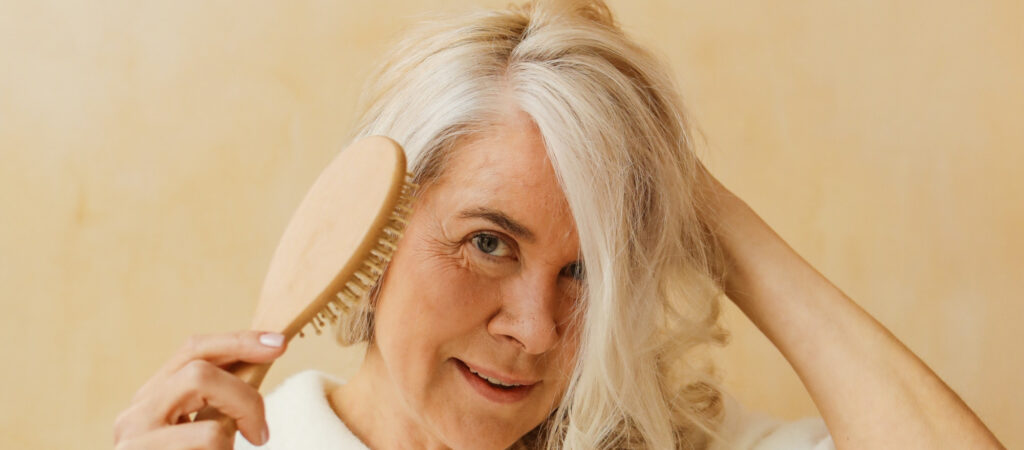Is Female Hormonal Hair Loss Reversible?
Are you noticing less hair where you used to have thick locks? You might be experiencing female hormonal hair loss. Excess androgens and declining estrogen could be why you’re losing more strands. While hormonal shifts aren’t always preventable, you may be able to reverse associated hair loss.
What Hormone Causes Hair Loss in Women?
As if side effects like mood changes and weight gain from hormonal shifts weren’t enough, hair loss is fair game. An overabundance of male hormones such as androgens like dihydrotestosterone can cause hair to fall out. With dihydrotestosterone, known as DHT for short, hair follicles could become too small to grow hair. And fluctuations in female hormones like estrogen and progesterone can also disrupt your hair’s growth cycle.
Variations in how much estrogen and progesterone your body makes are more common during pregnancy or menopause. However, you may start noticing the changes years before menopause. This stage is known as perimenopause, which usually begins between 40 and 44. But for a few women, signs of perimenopause could kick off in their 30s. Thinning hair from hormonal shifts might be one of them.
Get a personalized treatment plan with prescription and/or OTC medications for your hair and scalp concerns.
Estrogen and Progesterone
As women approach menopause, the ovaries begin to make less estrogen and progesterone. These are the “female hormones” responsible for a woman’s reproductive cycle. When the body’s production of female hormones declines, it can impact other parts of the body. These include the brain, bones, and hair follicles.
A study found 52.2% of postmenopausal women experienced some hair thinning or female pattern hair loss. Most study participants reported mild hair loss, but 22.6% said they had moderate loss. About 4.3% indicated severe hair thinning.
While the exact link between menopause and hair loss remains a mystery, declining estrogen appears to be a reason. Hair follicles also respond to changing female hormones, which may cause more strands to go into a resting versus a growth phase. This may be why menopause isn’t the only change that can lead to female pattern hair loss. Pregnancy is another time when female hormones shift, potentially causing thinner locks.
What Lifestyle Changes Can I Make To Restore Hormonal Hair Loss?
Dealing with hormonal hair loss can be a blow to a woman’s self-esteem. It’s natural to want to stop hair thinning and restore healthy growth. While it’s best to see a medical professional about your hair loss, there are lifestyle changes you can make that could help restore your hair to its original thickness and shine.
Nutrition and Exercise
What you eat and how often you move influences more than your looks. A well-balanced diet and exercise routine impact how well your body functions on the inside. Vitamin and mineral deficiencies can exacerbate or even cause hair loss. Check your daily intake of omega-3 fatty acids, protein, iron, B vitamins, and folic acid. If you’re not sure how much you should consume, ask your medical provider.
Reducing stress is an additional step you can take to support healthy hair growth. Regular exercise can lower stress levels and manage some of the side effects of hormonal changes. Increased stress is linked to higher cortisol levels, which can be associated with hair loss. Exercise keeps cortisol levels in check and fights other side effects such as weight gain and insomnia. Your hair loss may also improve if you stop smoking, stay hydrated, and take vitamin supplements.
Gentler Hair Care
Changing your hair care routine can also help mitigate hormonal hair loss. Hair styling practices with heat and harsh chemicals typically weaken hair. Think of tight ponytails, hot oil treatments, and at-home hair dye. Using the blow dryer every day on the highest setting can also make hair strands more prone to breakage.
Try letting your hair dry naturally on days you don’t have to be somewhere right away. When you must blow dry, put the setting on low or use a diffuser. Wear your hair down more often and limit your use of store-bought chemical treatments. These include dyes, perms, straighteners, and relaxers.
What Other Treatments Are Available for Hormonal Hair Loss?
Besides lifestyle changes, over-the-counter and prescription treatments are available for hormonal hair loss. Some come in the form of topical shampoos and medications. Others are systemic treatments that address hormonal imbalances in the body.
Topical Treatments
Minoxidil is a go-to topical treatment for female pattern hair loss. It works by increasing blood flow to hair follicles. For maximum effectiveness, doctors encourage daily use for at least six months.
You might also find success with shampoos with antifungal medicine, like ketoconazole. This medication can decrease inflammation, which may be responsible for hair loss.
Prescription Medications
Prescription medications address hormonal hair loss by restoring hormonal balance. A doctor might put you on spironolactone. Anti-androgen medications, such as spironolactone, reduce androgen production.
Treating Female Hormonal Hair Loss
If you suspect hormonal imbalances are causing your hair loss, you don’t have to suffer in silence. Scheduling a consultation with a medical professional can help you find the right answers. Once you confirm hormones are behind your thinning hair, you can start a personalized treatment plan to reverse it.





